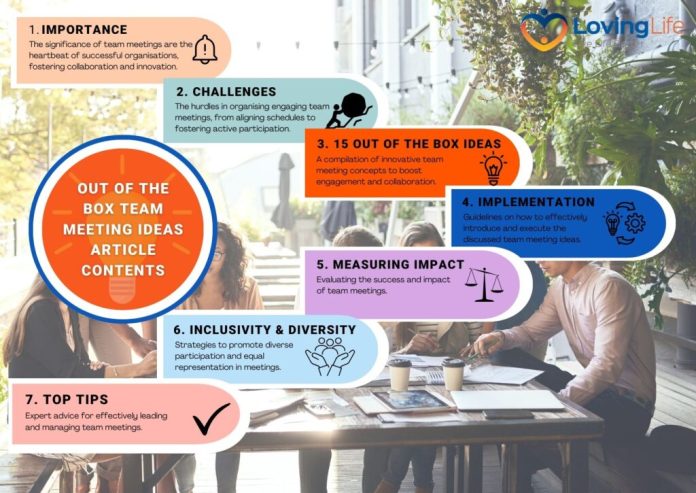Team meetings are a cornerstone of organizational communication, fostering collaboration, brainstorming, and problem-solving among team members. As the workplace landscape continues to evolve, so too do the methods and technologies used in meetings. According to a 2022 survey by Gartner, 82% of businesses plan to allow employees to work remotely at least part of the time, further emphasizing the importance of innovative team meeting solutions. The shift toward hybrid and remote work models has accelerated the adoption of digital tools and transformed how we conduct team meetings, making them more flexible, engaging, and efficient.
Emerging technologies such as artificial intelligence (AI), virtual reality (VR), and cloud-based collaboration platforms are shaping the future of meetings. These tools are designed to streamline communication, enhance productivity, and ensure that even geographically dispersed teams stay aligned. In fact, the global team collaboration software market is expected to grow at a CAGR of 13.2% between 2021 and 2028, showcasing the increasing reliance on digital solutions for effective teamwork.
This blog will explore key trends and innovations shaping the future of team meetings, including the rise of virtual meetings, AI-enhanced productivity tools, and the growing importance of real-time collaboration platforms. Understanding these trends will not only help organizations stay ahead but also foster a more dynamic and efficient meeting culture. By embracing these changes, businesses can ensure that their team meetings are not just routine discussions but powerful tools for innovation and growth.
12 key trends and innovations shaping the future of team meetings
1. Integration of Communication Tools like Clariti
The future of team meetings lies in seamless communication platforms that unify multiple channels. Clariti integrates email, chat, voice calls, and document sharing into a single thread, making it easier for teams to collaborate without switching between apps. This contextual communication ensures that all relevant information stays connected, improving productivity and reducing time spent searching for files or past conversations. According to a McKinsey report, companies that streamline communication see a 20-25% increase in productivity. For instance, a remote team using Clariti can conduct virtual meetings while simultaneously referring to previous emails and chats, ensuring nothing is missed and decisions are made faster.
2. AI-Powered Meeting Assistants
Artificial Intelligence is transforming how meetings are conducted. AI tools can transcribe conversations, summarize key points, and even suggest next steps based on the discussion. Research from Deloitte shows that AI-based tools can reduce meeting times by 20%. In team meetings, AI can help automate repetitive tasks like scheduling or distributing meeting minutes, allowing participants to focus on strategic discussions. Imagine a global team relying on AI to capture action items during a brainstorming session, ensuring nothing is overlooked.
3. Virtual and Augmented Reality in Meetings
Virtual Reality (VR) and Augmented Reality (AR) are enhancing team meetings by creating immersive experiences, especially for remote teams. These tools enable virtual environments where team members can interact as if they were in the same room. According to Statista, the AR/VR market is projected to reach $72.8 billion by 2024, with businesses increasingly adopting this technology. A scenario could involve design teams using AR to visualize a product prototype during a meeting, improving understanding and collaboration without needing to be physically present.
4. Real-Time Collaboration Tools
Collaboration platforms that allow for real-time updates and document sharing are essential for efficient team meetings. Tools like Google Workspace and Microsoft Teams enable teams to co-edit documents, track changes, and provide instant feedback during meetings. The Harvard Business Review reports that real-time collaboration reduces project timelines by up to 25%. For example, during a marketing meeting, team members can simultaneously update a campaign strategy document, ensuring everyone’s input is considered in real time.
5. Data-Driven Insights and Analytics
Data analytics are playing a bigger role in optimizing team meetings. Platforms now provide insights into meeting effectiveness by tracking metrics like participation levels, time spent on each agenda item, and follow-up actions. A report by Accenture states that businesses using data-driven decision-making increase their productivity by 33%. A scenario might involve HR using meeting analytics to identify which departments need more support based on their participation levels, helping managers tailor future meetings accordingly.
6. Remote Meeting Culture and Flexibility
The rise of remote and hybrid work has led to a cultural shift in how team meetings are perceived and conducted. Flexibility is key, with asynchronous meetings and flexible attendance becoming more common. According to a Slack survey, 72% of employees prefer hybrid meeting models, where not everyone needs to attend live.
Instead, recorded meetings and shared documents allow employees to review content on their own time. This flexibility can reduce meeting fatigue and increase overall engagement. For instance, a distributed team can hold an asynchronous meeting where team members from different time zones contribute via recorded updates.
7. Asynchronous Meetings
With global teams operating in multiple time zones, asynchronous meetings have become a popular trend. These meetings don’t require all team members to be present at the same time. Instead, participants contribute through recorded updates, shared documents, and task management tools. A report by Buffer shows that 43% of remote workers prefer asynchronous communication. In practice, a software development team could provide updates via video recordings, allowing teammates in different time zones to catch up on progress without the need for live meetings.
8. Focus on Inclusivity and Diversity in Meetings
Companies are increasingly recognizing the importance of inclusive team meetings where every participant’s voice is heard, regardless of location or role. Diverse teams bring a wider range of perspectives, leading to better decision-making. According to Deloitte, inclusive teams outperform their peers by 80% in team-based assessments. In practice, team leaders can foster inclusivity by ensuring remote members have equal speaking opportunities, using tools like polls or chat functions to gather input from everyone.
9. Shorter, More Focused Meetings
The trend towards shorter, more concise meetings is gaining traction as companies aim to combat meeting fatigue. Research from Atlassian shows that the average employee spends 31 hours in unproductive meetings per month. To counter this, companies are adopting shorter, agenda-driven team meetings. For example, teams might implement daily stand-up meetings lasting no more than 15 minutes, where each member briefly discusses their progress and any roadblocks, ensuring focus without wasting time.
10. Video-First Culture
With remote work becoming the norm, video-first meetings are gaining importance. Video meetings help replicate in-person interaction and build stronger relationships within global teams. According to a report from Owl Labs, 90% of employees feel more connected with their team when using video in meetings. A scenario could involve a marketing team running virtual brainstorming sessions via Zoom or Microsoft Teams, where facial cues and body language help facilitate more engaging and effective discussions.
11. Cloud-Based Meeting Solutions
Cloud-based platforms are transforming how meetings are organized and conducted. These tools offer easy access to meeting resources, no matter where team members are located. According to Gartner, cloud services are expected to grow by 20.4% in 2023, highlighting the shift toward remote collaboration. For example, a product team might store all meeting recordings, notes, and tasks in cloud-based solutions like Dropbox or Google Drive, ensuring that everything is accessible for follow-ups and accountability.
12. Increased Use of Breakout Rooms
Breakout rooms, popularized by platforms like Zoom, allow teams to split into smaller groups for focused discussions within the same meeting. This trend is particularly beneficial for large teams, enabling more in-depth conversations on specific topics. Research from Forbes shows that smaller, focused discussions can increase engagement by up to 30%. For instance, during a quarterly review meeting, a company’s departments could split into breakout rooms to discuss performance metrics in detail before regrouping to share key takeaways.
These innovations reflect the changing dynamics of team meetings, ensuring they remain productive and efficient as the workplace evolves.
Conclusion
The future of team meetings is being shaped by rapid innovations and emerging trends designed to enhance collaboration, inclusivity, and productivity. As organizations embrace hybrid and remote work models, the demand for more effective team meetings has led to the integration of advanced technologies like Clariti, asynchronous communication, and video-first cultures. These innovations not only streamline workflows but also create a more inclusive environment, ensuring that global teams stay aligned and engaged.
By adopting cloud-based solutions, leveraging breakout rooms, and reducing meeting length, companies can foster a more focused and efficient communication culture. As team meetings continue to evolve, staying ahead of these trends will be key to maintaining productivity and strong collaboration. Businesses that prioritize these advancements will empower their teams to work more cohesively, leading to greater overall success in the future workplace.








